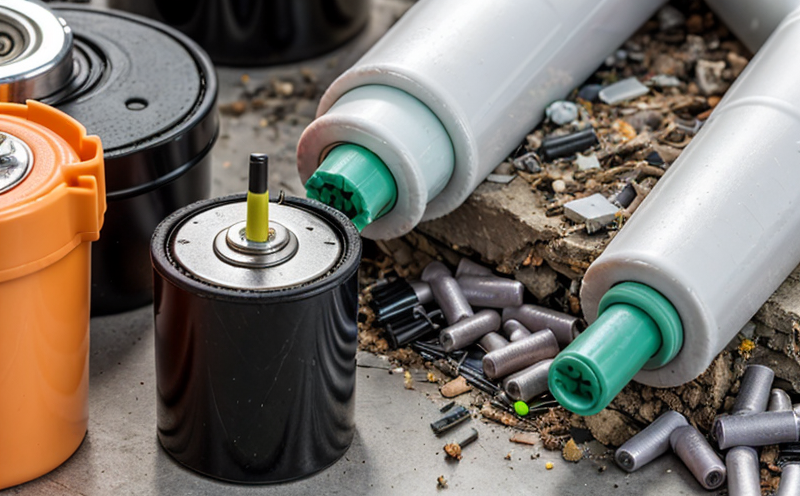ANSI C18.2M End-of-Life Testing of Portable Secondary Batteries
The ANSI C18.2M standard is a critical pillar in the battery recycling and end-of-life testing sector, ensuring that portable secondary batteries undergo rigorous assessment before disposal or recycling. This service ensures compliance with stringent environmental regulations while preserving valuable resources.
Portable secondary batteries are rechargeable cells used in various consumer electronics such as smartphones, laptops, power tools, and medical devices. The lifecycle of these batteries is characterized by repeated charging and discharging cycles until they reach the end-of-life (EOL) stage. At this point, the battery’s performance degrades to a level where it no longer meets operational standards.
The ANSI C18.2M standard provides a structured approach to evaluate the EOL condition of these batteries. It mandates tests that assess several key parameters including internal resistance, impedance, voltage, and capacity retention. These metrics help determine whether a battery can still be used for secondary applications (such as backup power systems) or must proceed directly to recycling.
Compliance with ANSI C18.2M ensures that batteries are properly managed at the end of their useful life. This not only adheres to environmental protection laws but also contributes to the circular economy by maximizing resource recovery and minimizing waste.
The testing process involves several steps, starting with the selection of representative samples from a batch of batteries. These specimens undergo rigorous conditioning to simulate real-world usage conditions before being tested according to ANSI C18.2M protocols. The tests provide detailed insights into the battery’s remaining capacity and other performance metrics.
Once testing is complete, comprehensive reports are generated detailing each parameter measured. This information allows stakeholders to make informed decisions about how best to manage the batteries at EOL. For instance, if a battery still retains significant capacity, it may be reconditioned for secondary use; otherwise, it can proceed directly to recycling.
The ANSI C18.2M standard is recognized globally and is widely used in industries that rely heavily on portable electronics. By adhering to this standard, manufacturers, recyclers, and other stakeholders ensure consistent quality control throughout the battery lifecycle.
Applied Standards
| Standard | Description |
|---|---|
| ANSI C18.2M-2021 | This standard specifies the procedures for end-of-life testing of portable secondary batteries, including measurement methods and acceptance criteria. |
| IEC 62597:2014 | An international standard that complements ANSI C18.2M by providing additional guidelines for the design and performance of rechargeable batteries used in portable electronic devices. |
International Acceptance and Recognition
The ANSI C18.2M standard is internationally recognized and widely adopted across various countries, including the United States, Canada, Europe, and Asia-Pacific regions. Its acceptance stems from its rigorous approach to ensuring safe and responsible management of portable secondary batteries.
Compliance with ANSI C18.2M is mandatory for manufacturers seeking to export their products to markets that have stringent environmental regulations. Many countries mandate the use of this standard as a means to ensure that batteries are properly recycled or reused at EOL, reducing environmental impact and promoting sustainability.
For quality managers and compliance officers within these regions, adherence to ANSI C18.2M is not only a regulatory requirement but also a best practice for maintaining corporate social responsibility (CSR) standards. By implementing this standard, organizations demonstrate their commitment to sustainable practices and responsible resource management.
Environmental and Sustainability Contributions
The ANSI C18.2M end-of-life testing service plays a pivotal role in advancing environmental sustainability by ensuring that portable secondary batteries are managed responsibly at the EOL stage. This process contributes to several key sustainability goals:
- Resource Conservation: By assessing battery performance before disposal, the standard helps identify batteries suitable for reconditioning or repurposing instead of outright recycling.
- Emission Reduction: Proper management at EOL minimizes the release of harmful chemicals into the environment, contributing to cleaner air and water.
- Waste Minimization: Recycling batteries according to ANSI C18.2M protocols ensures that valuable materials are recovered and reused, reducing overall waste generation.
The service also aligns with broader environmental initiatives aimed at promoting a circular economy. By extending the lifecycle of batteries through reconditioning or repurposing, stakeholders contribute to long-term sustainability objectives while adhering to international best practices in battery management.





